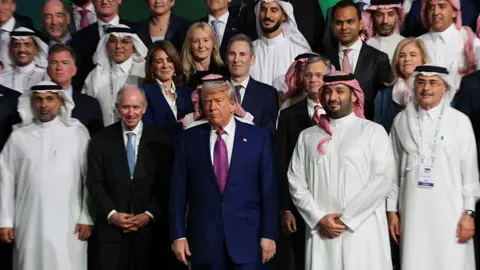In a dynamic display of international diplomacy, U.S. President Donald Trump recently embarked on a significant visit to Saudi Arabia, where he emphasized the country’s strategic importance to the United States, declaring that there is “no stronger partner” than Saudi Arabia. This trip marks a critical moment in Trump’s second term as it revolves around forging deeper financial ties with Gulf nations. Prominently featured during the visit was a staggering $142 billion arms deal, which is not only a significant economic move but also a reflection of the longstanding military relationship between the U.S. and Saudi Arabia.
The announced arms deal, alongside additional investments that Saudi Crown Prince Mohammed bin Salman projected could reach an impressive $1 trillion, highlights the potential for enhanced collaboration. Historically, Trump began his first term in 2017 with Saudi Arabia as his inaugural international destination, symbolizing the importance of this ally. During this current trip, he aims to foster economic partnerships with not just Saudi Arabia but also with Qatar and the United Arab Emirates, reinforcing his administration’s emphasis on investment and economic growth.
At the heart of Trump’s declaration in Riyadh was his announcement to lift sanctions on Syria, a move aimed at providing the war-torn country a chance to “achieve greatness.” This signifies a potential shift in U.S. foreign policy as Trump aims to align his diplomatic moves with the interests of Saudi Arabia, specifically in relation to the evolving political landscape in Syria. Strikingly, this policy decision follows over a decade of sanctions aimed at pressuring former President Bashar al-Assad’s regime.
The reception awaiting Trump in Saudi Arabia was nothing short of grand, with a vibrant lavender carpet prepared for his arrival—a change from the traditional red carpets indicative of the kingdom’s cultural symbolism of generosity and the desert’s wildflowers. Crown Prince Mohammed bin Salman extended a warm welcome, underscored by an honor guard of regal Arabian horses accompanying Trump’s limousine, contrasting sharply with the more subdued reception given to former President Joe Biden during his visit amid strained relations following the journalist Jamal Khashoggi’s murder.
In his addresses during the visit, Trump highlighted the importance of commerce and economic development in transcending regional violence and division, notably while emphasizing the benefits of foreign investment in the United States. He is keen on attracting foreign investors to bolster the U.S. economy, which has been a core focus of his administration since he took office for a second term. Notably, Trump has fostered a friendly relationship with Crown Prince Mohammed bin Salman, indicating a personal rapport, as he expressed his admiration, claiming, “I like him too much” in regard to the Saudi leader.
Further solidifying his intent to secure ongoing collaborations, tech and business icons such as Elon Musk and Sam Altman joined Trump during significant engagements in Riyadh, reflecting a strong interest among business leaders in the region’s lucrative markets. Trump articulated his aspiration to see Saudi Arabia join the Abraham Accords, a contentious proposal that acknowledges the normalization of relations with Israel, contingent upon advancements regarding Palestinian statehood.
Throughout his trip, Trump also briefly addressed the ongoing conflict in Gaza, mentioning that the residents of the region deserve a better future and acknowledging the implications of Hamas’s actions. The mention of lifting sanctions on Syria was a bold declaration hinting at a potential pivot in diplomatic relations, as he stated that this was a request from Crown Prince Mohammed bin Salman himself—underscoring the intertwined nature of their political contexts.
As Trump continues his diplomatic outreach, he was poised to advance from Saudi Arabia to Qatar and the UAE—both of which have shown significant economic investment potential, reaffirming the commitment of these nations to invest substantially in the United States over the coming decade. This high-stakes visit encapsulates not only Trump’s ambition to solidify America’s economic ties in the region but also showcases the ever-shifting landscape of Middle Eastern geopolitics.



